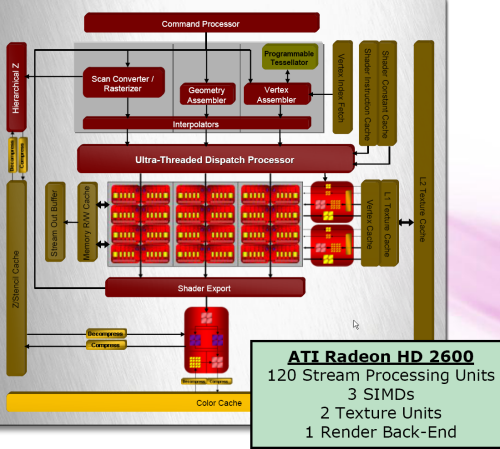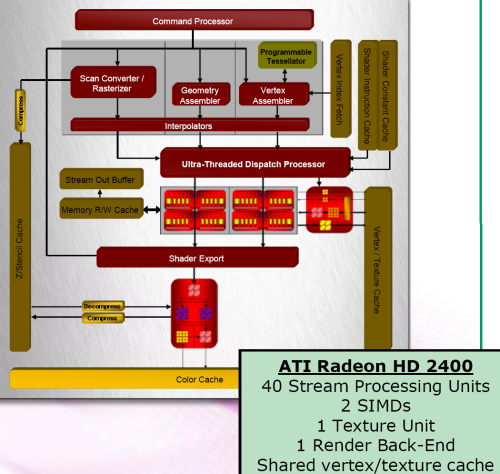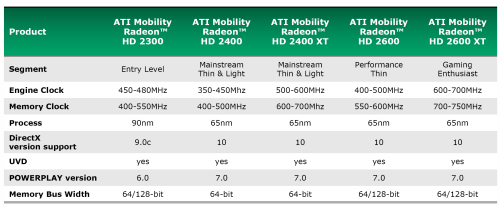HD 2600, 2400, Mobility, etc.
AMD Radeon HD 2600 and HD 2400 series
The HD 2900 XT will gain most of the attention today. It's the fastest graphics card shipped under the Radeon banner and we're allowed to publish benchmarks, which is always nice.However, AMD is launching a top-to-bottom line-up for its DX10 parts, and here's how the other cards, the Radeon HD 2600 and HD 2400, stack up.
Thankfully, the HD 2600's architecture is, for all intents and purposes, a shrunken version of the Radeon HD 2900 XT - and in more ways than one.
The obvious chops are to the stream-processors, down from 320 to 120. The texture units are lopped in half, expectedly, and there are only four ROPs and eight texture-filter (FP32) units. The programmable tesellator and other useful gubbins survive intact.
But the devil is in the details that you don't see. The Radeon HD 2600 is based on a 65nm manufacturing process (65G+) and interfaces with its local memory via a 128-bit interface. There will be both Radeon HD 2600 XT and PRO SKUs, differentiated by core and memory speeds alone.
The lopping off of the architecture brings down the transistor count to around 390m. The HD 2600 is designed to compete with NVIDIA's GeForce 8600 series, and it will be interesting to see how they match up. We expect core/shader speeds between 600-800MHz and memory speeds of between 800-2200MHz (effective, GDDR3), depending upon partner implementation.
The Radeon HD 2400 is the runt of the DX10 litter. Pure processing power is hampered by it only having two SIMDs, with a total of 40 stream-processing units. There's only a single texturing unit, meaning four texture-filter (FP32) units and, saving space and cost some more, a single shared vertex/texture cache. The ROPs stay the same as the HD 2600 series, though.
The memory interface is further trimmed to an external 64-bit and we expect to see models sporting both DDR2 and GDDR3, up to 256MiB. The HD 2400 is based on the same 65nm process and will carry around 180m transistors and also be broken down into XT and PRO variants.
We expect it to retail at current X1300 prices, so DX10 for around £50. Just don't turn up the resolution too much!
AVIVO HD
Carrying on the HD theme is an update to AMD's AVIVO video-processing technology. Thinking about the challenges imposed by having to decode the computationally expensive VC-1 and H.264/AVC codecs; the two most-common used for HD DVD and Blu-ray pre-recorded material, respectively, AMD's realised that the low-to-mid-range GPUs need a helping hand.Our GeForce 8600 GTS examination pointed out that NVIDIA's Bitstream Processor helps the GPU accelerate all the decoding steps present during H.264/AVC playback. The same, AMD reckons, cannot be said about NVIDIA's VC-1 entropy decode (the first stage).
In contrast, AMD's dedicated Universal Video Decoder (UVD), present on both HD 2600 and 2400 series, does the whole job, internally, on a dedicated processor, leaving the CPU and GPU to do other wonderful things. As we cannot publish results for Radeon HD 2600 and HD 2400 cards, we cannot confirm this, but watching a frenetic 1080p demo run off a HD 2600 card, CPU utilisation hovered at around 15 per cent.
The Radeon HD 2900 XT being the GPU powerhouse that AMD thinks it is, video decoding is handled by the voluminous shaders.
Following on from NVIDIA's GeForce 8600 line, the Radeon HD 2000 series has HDCP-support built in, with the number of ciphers matched up to the outputs. All HDCP-compliant ports will offer dual-link compatibility, too. Great for for owners of Dell, Apple and HP 30in panel, all 50 of you.
HDMI routing
Most current graphics cards that support HDMI, usually via a Silicon Image transmitter, require audio to be fed from the motherboard into the graphics card through a separate cable from the board's S/PDIF connector, assuming you'd like both audio and video transferred through a single cable.
AMD's incorporated an audio 'controller' into the GPU such that your motherboard's audio device, be it onboard or discrete, can be ultimately routed via PCIe, into an HD 2000 series GPU, and pushed out together with video. Microsoft's UAA driver does the routing for Vista and AMD has a downloadable driver for Windows XP that does the same job.
The HD 2000 series will also feature an optional adapter that converts a regular DVI output into full HDMI (sound routing permitting).
It all sounds good in theory but we note that AMD is only adhering to V1.2 HDMI spec, so doesn't support later features such as TrueHD and DTS-HD lossless Codecs and audio syncing.
Brief summary
The Radeon HD 2600 and 2400 series will be the volume sellers for AMD. Retail availability is slated as July 1st and we'll have more information on pricing and specs then. Naturally, all HD 2000 series products will support CrossFire, be it via the PCIe bus on low-end parts or via dedicated bridges.Mobile madness!
When you believe you have a good architecture, spread the love around.
AMD also thinks that now is a propitious time to leverage its DX10 technology into mobile form.
From the table above, you can see that it's launching four brand-new mobile SKUs based on the same 65nm technology as the desktop counterparts and shoehorning an older technology into the HD range under the HD 2300 banner.
Mobility Radeon HD 2400 will feature a similar architecture to the desktop HD 2400, albeit with slower-clocked core and memory speeds, as befits a mobile part. Moving up the range, we see that the DX10-supporting SKUs continue to mirror their desktop counterparts. We like the fact that all new products carry the UVD processor for non-CPU-intensive playback of HD DVD and Blu-ray content.
The all-new SKUs feature the latest iteration of AMD's PowerPlay power management technology and are based on a wattage-conserving 65nm manufacturing process.
We'd love to tell you how well the Mobility Radeon HD series compare against the latest and greatest from NVIDIA but we'll have to wait until July before samples of the DX10 mobile parts are forthcoming.












